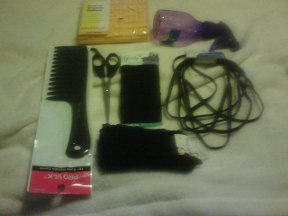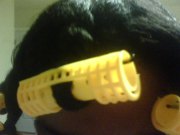Also, I don’t want to read labels. It’s a big thing these days to look at the ingredients of stuff that you buy for your beauty health care and to know what’s inside the container. I, for one, don’t understand big chemical and scientific data. I DON’T WANT TO READ THE BOTTLE. I don’t want to spend any more extra time. I just want to go to the store and pick the container up and use it.
And I don’t like shopping. Nope. Sure don’t. Not at brick and mortar stores. I like to surf the net and have it end up on my doorstop when I get home. The only place I “need” to go to is the grocery store. (Side Note: I go to JCPenny’s once every 18-24 months when I need cloths).
So, doing the “products” thing to manage my hair, while I transitioned from relaxed to natural, “just wasn’t going to do”
And, I decided I wasn’t, was not, going to go natural because it was just too much money! I’m a Cheapo. I haven’t been to a hair dresser in YEARS! Because I couldn’t stand the hours in the shop and I couldn’t stand dishing out all those Hundreds. I even figured out how to do my own hair for my own wedding (and yes, that’s me on the website).
So nope. Doing the “products” thang and Going Natural was not Cost Effective for me.
Then, while researching one day, I found an answer! TADA!! FOOD!!! Yep, Food!
If I can’t eat it, or wear it, I’m not using it. Yep, that’s right. Going Natural using Homemade Products and Recipes. So what does that mean? What kind of “products” are those? Well, here’s a list.
- Coconut Oil
- Baking Soda
- Extra Virgin Olive Oil
- Apple Cider Vinegar
- Honey
- Aloe Vera Gel (Can’t eat but I can put it on my skin)
- Almond Oil (Optional)
- Jojoba Oil (Optional)
So, yeah, I can cook with Coconut Oil, and Baking Soda has all kinds of usages such as brushing my teeth, and soaking up odors in the refrigerator or washing cloths. And Apple Cider Vinegar I use on warts/moles, and to clean out my biological system. Honey I can put in my tea or on some bread rolls. And Aloe Vera, I can put on my rough feet. Almond OIl can be used to remove those dark circles under my eyes and a substitute for Olive Oil for salad dressings and also for cooking stuff. Jojoba Oil I can use on my rough skin too, especially as a Lip Balm. And lastly there’s Olive Oil. Olive OIl I put on the bottom of a pot, add some popcorn kernels, and shake that bad boy — Popcorn Night for my Netflix Nights!!
Uh huh. Yep. If the “product” didn’t work, then I could use it for something else.
SIDE NOTE: I couldn’t find Almond Oil or Jojoba Oil in Wal-Mart, and I only bought them because my husband and I happened to have a 30 minute wait for a restaurant we wanted to eat at and GNC (a nutritional supplement store) was next door and we went in. Everything else, I got at Wal-Mart down the cake/cooking aisle and at a Beauty Supply Store around the corner. And here’s where the only $$$ signs popped up: Almond Oil and, especially Jojoba Oil, was expensive! But I got it because I found out that when I use Olive OIl as a Spritz with water, I broke out in a rash all over my chest and back (but not in my hair). I could just cover up and still use the Olive OIl, but I’m too lazy to do all that. Now I use JoJoba OIl and water Spritz (3 part water, 1 part Oil)–well very little oil for the JoJoba because that bottle only has 4 oz and it was the same price as the Almond OIl that was 16 oz.
For me, I already had half of the items above. The only other things I had to add to it was: 1) a spray bottle (from Wal-Mart), 2) the perm rod rollers (which my Mom gave to me because she no longer using them), and 3) the Wide Tooth Comb (from the Beauty Supply Store around the corner).
Here’s a list of the items I’m using to transition my hair from relaxed to natural.
- Baking Soda
- Apple Cider Vinegar (For those who don’t know, it’s not two separate containers; it is an actually bottle that says “Apple Cider Vinegar”)
- Honey (Yep, the Honey bee stuff)
- Extra Virgin Olive Oil
- Coconut Oil (or Extra Virgin Coconut Oil — I got the regular stuff LouAna)
- Aloe Vera Gel (e.g. 12 oz Fruit Of The Earth Aloe Vera Gel)
- Almond Oil (16 oz Optional)
- Jojoba Oil (4 oz Optional)
- 2 bowls (that can hold 2 cups of water)
- 2 Water Bottles (Empty the water out of the water bottle like Osaka or Dasani for example)
- Ice Pick, Dremel, or Reamer (Something to make a 4mm hole into plastic) and put a hole in each cap of the water bottles
- 3/4 inch perm rod (12 rollers)
- Shower Cap
- Silk or Satin Bonnet or Scarf
- Spray Bottle
- Wide Tooth Comb (and I mean W I D E – like 0.5 inches Teeth Wide..I couldn’t find at Wal-Mart so this was at the Beauty Supply store around the corner)
- Towel
- Cheap Hair Conditioning (We’re not using any kind shampoo at all since it dries out the hair. So, if you already have some Hair Conditioning, just use that to wash your hair)

So there you have it, from Ole Cheapo herself. Yeah, I have to do a little mixing, but it’s worth it.
This is what’s been working for me and the $$$ is just fine! 🙂


 I wanted to make a blog where it tells you exactly what I did while transitioning my hair. I’ve just started transitioning. My last relaxed hair was in October 2010. I’ve done ALOT of research, for several months, on the Internet about how to transition your hair without the BIG CHOP. I’ve looked at blogs, YouTube and Websites on the “What To Dos”, and I’ve learned a lot of things before making my decision.
I wanted to make a blog where it tells you exactly what I did while transitioning my hair. I’ve just started transitioning. My last relaxed hair was in October 2010. I’ve done ALOT of research, for several months, on the Internet about how to transition your hair without the BIG CHOP. I’ve looked at blogs, YouTube and Websites on the “What To Dos”, and I’ve learned a lot of things before making my decision.